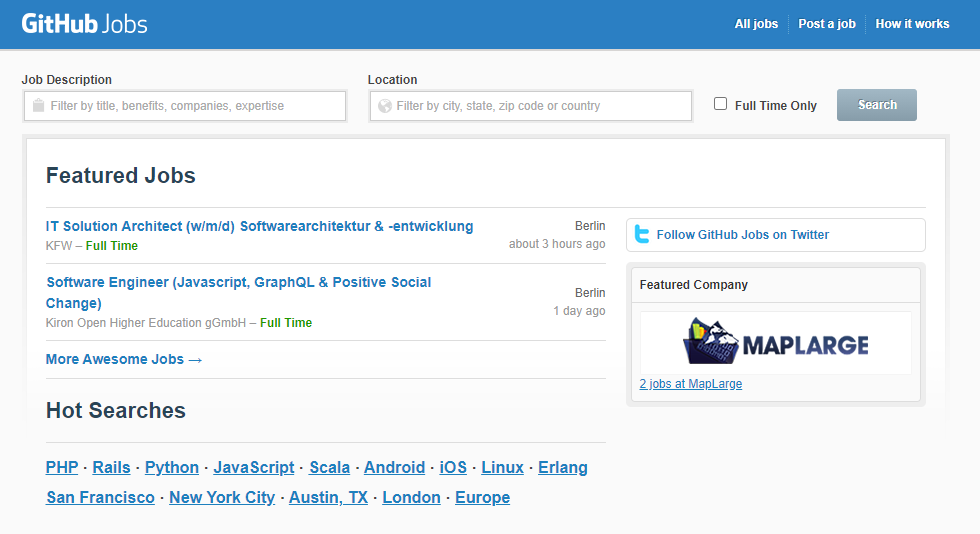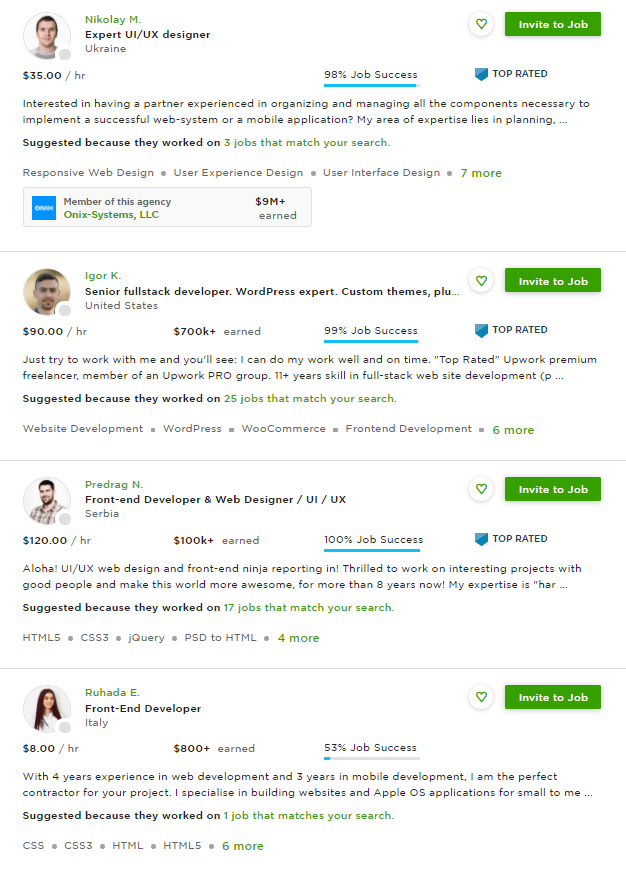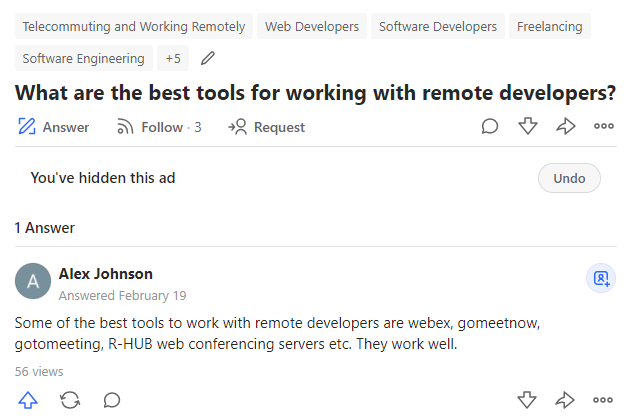Day in, day out, technical recruiters and hiring managers ask themselves the same question: “How do you find good developers?”. In fact, 74% of recruiters say that they’re “barely able” or “unable” to find qualified tech candidates (CodinGame 2020 survey).
Sourcing qualified candidates is the most crucial step of the recruitment process. There’s really not much point in optimizing your screening process or your onboarding process, if you can’t find candidates in the first place… right?
So, we’ve listed 15 strategies that will help you to find your next top software developer. We’ve chucked in a ton of advice, resources and tools. Dig in!
> Oh, by the way, we’ve put all of our articles and resources on how to find and hire developers here. <
How to find good developers
1. Job boards
Job boards (Indeed, Monster, etc.) have been around since… forever. Today, they’re buzzing with opportunities.
However, they have one major downfall: they’re flooded with job offers and it’s not always easy to stand out. As demand for tech talent continues to climb, this is only going to get worse.
To get seen and paid attention to, make sure you’re continuously and simultaneously posting on niche job boards, where there’s a little less noise (oh and make sure you’re publishing perfect job descriptions too!).
Niche tech job boards
Niche job boards for hiring developers include:
Well-known web-based hosting service and software company, GitHub, have created their own job posting site called GitHub Jobs. The site is tech-oriented and straightforward, with a fixed price of $450 per job listing.

Stack Overflow also have their own job site. Stack Overflow Jobs is carefully engineered to help developers find quality jobs. The site claims to filter companies and recruiters, so as to avoid any spammy or irrelevant messages.
2. Referrals
Whether you simply encourage your team to put anyone they think might be right for your company forward or whether you set up a fully fledged referral program, it’s definitely a good idea to activate your teams’ networks when looking for developers.
Some organizations imagine their referral program as part of a high-level strategy. They pay big bucks for introductions that result in successful hires, and invest in automation technology.
EmployeeReferrals, for example, is one of the best referral automation tools on the market. The software allows you to, automatically, send messages, remind employees to keep on track with their referral duties, distribute rewards, etc. It does the hard work for you!
3. Internal staff mobility
Admittedly, internal mobility and reskilling is only an option for larger corporations. Surprisingly though, when looking for qualified developers, these bigger companies tend to undervalue and overlook their own workforce.
Today, the subject is on the rise. In Deloitte’s 2019 Global Human Capital Trends survey, 79% of respondents rated the issue as “important” and a further 20% said that it was one of their top 3 priorities.
Indeed, hiring organizations are starting to understand the importance of supporting and facilitating internal mobility opportunities. They’re making room for movement between teams, jobs, positions and locations, as a natural “next step” in a programmer’s career.
“You can go out to the street and hire for the skills, but we all know that the supply of technical talent is limited, and everybody is going after it. Or you can do your best to step up and reskill your existing workforce to fill the gap.” – Scott Smith, AT&T’s senior vice president of Human Resources operations
4. Online coding competitions and recruitment events
An online coding competition is a smart way to find qualified software developers. With one event, you attract developers, promote your employer brand and assess potential candidates’ coding abilities.
Here at CodinGame, we regularly coordinate online coding competitions for organizations looking to hire developers (…). Hiring organizations can pick between a ready-to-go Clash of Code tournament or a custom-made coding game (with specific design assets, a unique game environment, etc.).
If you’re looking to organize an event that’s solely recruitment-orientated, why not organize an online job fair/event via a webinar service like Demio or WebinarJam?
Use your slot to tell potential candidates what they need to know (about internal communication processes, project management methodologies, company culture, technical stack, future development projects, etc.). Also, leave time for a live Q&A session.
Wait, there’s more! Since participants will have registered for your webinar using their email address, you can then reach out to them individually or collectively.
5. Freelance platforms
If you’re looking to find a freelance developer, using a freelance platform is quite obviously the easiest way to go. There are lots to choose from! Freelance platforms can usually be grouped into two categories: general and niche.
General freelance platforms
The most well-known freelance platforms fall into this category. For example:
On general freelance platforms, you’ll find an array of software programmer profiles. Development rates will vary massively depending on skill set, experience, location, etc.

Although it’s 100% possible to find the perfect fit for your project on these sites, it can be difficult to assess programmers’ skills and suitability for your job.
Niche freelance platforms for developers
Niche platforms, imagined especially for finding freelance programmers, generally have a more extensive technical screening process and provide you with a better screenshot of developers’ skills.
Examples of niche freelance platforms for developers:
From freelance to long-term software developer
It’s a little cheeky, but you never know, being an active and respected employer on a freelance website might just put you in touch with developers open to full-time opportunities…
Once you’re on their radar (and if you’ve put the necessary work into your employer brand) you’ve got a chance of them becoming candidates.
That said, DO NOT go spamming freelancers with full-time job offers. For starters, you’ll probably get flagged by whichever platform you’re using.
It’s one thing to mention an opportunity to a developer you’ve been working with on a particular project. It’s another thing entirely to stomp around freelancer sites looking for potential long-term candidates.
6. Slack communities
If you’re not one of the 12 million professionals using Slack, here’s a quick presentation:
Slack is an online messaging platform, designed mainly for team communication and collaboration. The company was founded in 2013 by Stewart Butterfield and has drastically reduced the use of email for internal communication!

On top of being used for work, Slack is increasingly used to form topic-focused discussion groups and communities.
There are some extremely cool and useful Slack channels out there for developers. These channels are split into general coding communities and communities interested in a specific programming language, framework, job or geographic region. TechBeacon have put together an extensive list of slack groups for developers in this article.
Some of the most active slack communities for coders include:
Woah, hold your horses! Before you go off joining every Slack channel there is, bear in mind that Slack communities are well-guarded and aren’t open to just anyone!
If you want to be able to lean on a developer Slack community for referrals or candidate applications, then you need to become an active member of said community.
If you set out requesting access to “developer-only” channels as an HR pro, you probably won’t get very far (sorry ?). However, if you’re a CTO, a tech hiring manager, or a developer, then you’ll have plenty to bring to the discussion and much more chance of being accepted.
Your best bet? Asking your tech teams if they’re already part of any lively Slack communities. Chances are they will be and (if they value you as an employer!) they’ll be more than happy to share an opportunity and put you in touch.
7. Tech forums
When it comes to tech forums, our advice is along the same lines as the advice given above.
You’ll only get out what you put in.
If you want to be able to reach developers hanging out in forums, then make sure that you’re an active participant. Don’t just post and pray, provide relevant answers to others’ questions.
Quora is one of the biggest question and answer forums out there. You can pitch in to all kinds of tech wonderings, such as:
- Is Flutter likely to replace Java for Android app development?
- What’s the coolest thing you can get a computer to do in 10 lines of code?
- What are the best tools for working with remote developers?
- How much does it cost to build an app prototype?

You’ll even find the answer to the question: What are the top tech forums? ?
- TechRepublic
- Techist
- CNET
- Tom’s Hardware Forum
- TUX Technology And Computer Support Forum
- Linus Tech Tips
- WebDeveloper.com
- Kirupa
- CodeGuru
8. Social media networks
Besides being valuable as promotion channels for your employer brand, social media networks can also bring you closer to finding your next full-time developer. Some networks, however, are more relevant than others.
You can tap into Twitter, Instagram, Facebook, etc. to find developers, but LinkedIn is still the odds-on-favorite.
Finding developers with LinkedIn
Although LinkedIn is flooded with recruiters like you, it’s still the number one network for finding developers who are open to new opportunities. Indeed, in our latest survey, we found that 74% of developers turn to LinkedIn to look for job openings.
So get searching! Use LinkedIn’s search options and recruiter tools or, if you’re feeling a little gangster, look into automating the analysis of LinkedIn data at scale. How? With a little help from your R&D team and a lot of help from growth hacking tools like Phantom Buster.
Phantom Buster is an automation and data extraction tool. You can use Phantom Buster to start hacking your recruitment with web scraping.
“LinkedIn Jobs Scraper comes as a useful addition to [LinkedIn’s recruiter tools] by allowing you to extract all the data from a list of jobs into a spreadsheet. This data can then be manipulated in Google Sheets or become the first step to a Zapier workflow. Start extracting all the available data of LinkedIn jobs today and set your hiring process on autopilot!”
9. Paid ads
Sometimes, a little budget can go a long way.
You can choose to pay to promote your job offers on job boards (you’re generally charged on a “pay-per-job” basis) or you can choose to experiment with other pricing models.
Pay-per-click (PPC), is the most popular alternative advertisement model for recruitment.
Finding developers with Indeed PPC
In 2006, Indeed announced the formal launch of “the first pay-per-click job advertising network”.
Today, Indeed is still the big cheese of job boards.
“Search engines have revolutionized the advertising industry with a pay-for-performance model, and now Indeed is the first to create a pay-per-click network for classifieds advertising.” – Paul Forster, CEO of Indeed
It’s very straightforward to set up a sponsored job posting on Indeed. You simply head to Indeed.com, click on “Post a Job”, enter the necessary information about your business and your carefully-crafted job description, then use the slider to sponsor your job advertisement (depending on your budget).
Then what? You optimize! If you want to optimize your ads like a pro, check out this article by Mike Matta, Paid Media Strategist at Brainlabs: Indeed Advertising.
Finding developers with Google Ads
Of course, Google is also an extremely integral part of the recruitment landscape.
Google is the search engine we all know and love. As for Google Ads, it’s Google’s advertising platform and offers businesses the opportunity to display sponsored posts on SERPs and across the Google Display Network.
Setting up a Google Ad for your IT recruitment campaign can be done in 10 steps:
- Get to grips with Google Ad vocabulary
- Organize your account into campaigns and ad groups
- Define your budget
- Pick your keywords
- Configure your keyword match types
- Select your landing page (your expertly-written job offer!)
- Choose between mobile or desktop, or both
- Write your ad
- Connect your Google Ads to Google Analytics
- Activate your campaigns – adjust and optimize!
The trickiest part of setting up your tech recruitment ad campaign is choosing the right search terms. This will determine if the right developers see your ad.
If you’re hiring developers who are fluent in Haskell, you might expect active job seekers to search for something like “developer jobs Haskell”, while passive job candidates might be searching more generally to resolve questions they encounter using that particular language.
This article tells you more about deciding on and narrowing down search terms: How to Run a Recruitment Campaign with Google Ads.
10. Graduate outreach
An increasing number of developers are side-stepping university and learning to code at boot camps or all by themselves (35% of developers consider themselves to be self-taught).
Still, talented students graduate from computer science courses every year. Why not reach out to them?
You can do so through social media groups, student recruitment events, mobile recruiting… or you can build and maintain strong long-term relationships with university campuses.
11. Internships
Your company can benefit massively from hiring tech interns.
Best case scenario 1: your tech intern brings your team extra productivity, sparks creative energy and encourages group responsibility, AND stays on as a full-time developer at the end of their course.
Best case scenario 2: your tech intern still has some studying to do after the internship. He or she remembers your company fondly, tells fellow students about you, AND comes back to apply for a position once they’ve graduated.
Worst case scenario: your tech intern falls short of the mark. He or she isn’t with you for long.
What have you got to lose!?
12. Professional recruiters and agencies
Although it’s one of the most expensive methods out there, you can’t go too wrong with a professional head-hunter or recruitment agency.
However, you definitely want to look for an agency that specializes in IT recruitment. Even better, look for an agency that will assess candidates’ technical skills before putting them forward.
At Smart Talent IT, for example, recruiters evaluate developers’ skills with CodinGame Assessment. They test between 400-700 applicants each month (on technologies such as Python, JavaScript, Ruby, Angular, HTML, CSS, Docker…) and successfully match applicants to positions in Colombia, the US, and Canada.
13. Creative sourcing methods
We know, it’s easier said than done, but… think outside the box!
Put your heads together and try and come up with creative ways to find software programmers. Ask yourself (and your team) these questions, and see if you can bump some good ideas off each other:
- Where do developers hang out?
- What makes your company unique?
- What impresses developers?
- Where do developers look for opportunities?
Creative PR agency, Uncle Grey, took the first question in the list and ran with it! They decided to pay several expert Team Fortress 2 players to promote their tech job opportunities within the game.
14. Your career website
True, improving your career website isn’t a way to actively go out and find developers (it’s no “looking under the bed or rummaging between the sofa cushions”). However, it’s pretty much a non-negotiable.
Why? Because not only do you need to get out there and find developers through outbound actions, you also need to pay close attention to your inbound recruitment.
Part of your Inbound recruitment strategy
Inbound recruitment is a hiring strategy where you proactively and continuously attract candidates. Your end-game is that these candidates choose you as their next employer.
It means making yourself attractive as an employer, pampering your online presence and generally sending out good vibes and content, with the hope that you’ll spark potential candidates’ curiosity.
Optimize your career page
Your career page is one of the first things you need to attend to. You need to make sure that any developers that come across your company page find the information and reassurance they need to become candidates.
How do you optimize your career page? Improve your UX, allow spontaneous applications, offer job alerts, share what it’s like to work for your company (remember, a picture is worth a thousand words)…
15. Your existing talent pool
Last but not least, when looking for developers, it’s always a good idea to turn to your own tech talent pool.
Simply put, your talent pool is a database of potential candidates. These candidates are generally qualified and have previously expressed an interest in your company. Whether they’ve applied for a previous position, taken part in an informal tech meetup, signed up for a newsletter…
With a bit of luck, you’ve kept in touch with and “nurtured” these contacts. In any case; you definitely want to take the time to check in!

